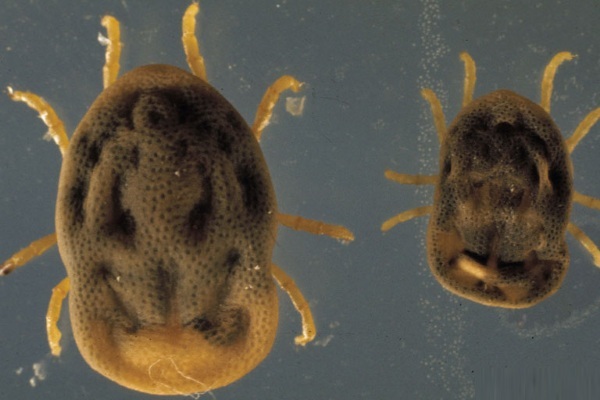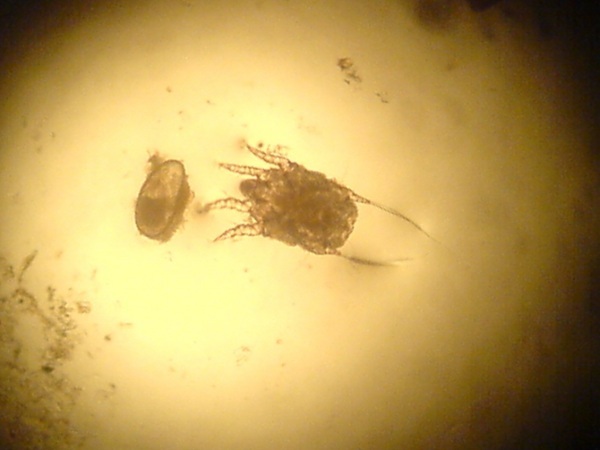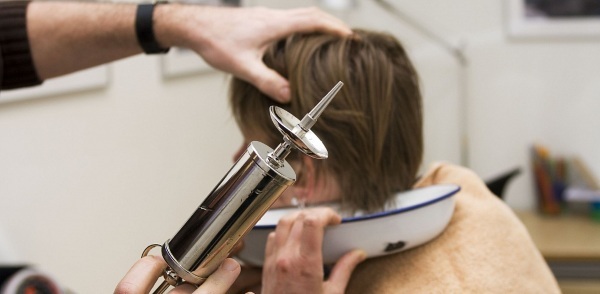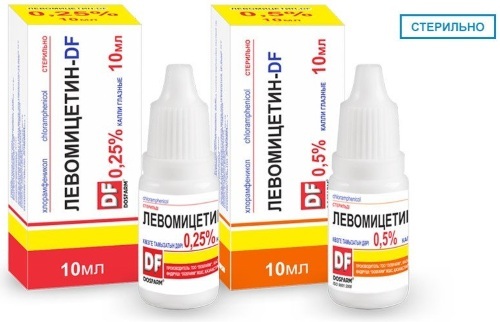Ear mite substitutes itself a parasite, which is rare in humans and affects the area of the auricle. Several types of small representatives of ticks are easily able to get into the ear in different ways, causing body pain, damage and chronic diseases of a different nature that require systemic treatment.
In this case, the health of a person directly depends on the rate of detection of the parasite, therefore, the treatment of an ear mite should be started immediately.
Record content:
- 1 Characteristic
- 2 Symptoms
- 3 Causes
-
4 Diagnostics
- 4.1 Inspection and collection of information
- 4.2 Direct microscopy method
- 4.3 Analysis of the discharge of the sebaceous glands
- 4.4 Surface biopsy method
- 5 When to see a doctor
- 6 Treatment methods
-
7 Medications
- 7.1 Metronidazole (trichopolum)
- 7.2 Tinidazole (Fazigin)
- 7.3 Blepharogel
- 7.4 Benzyl benzoate
- 7.5 Levomycetin
- 7.6 Alcohol solutions
- 7.7 Tetracycline ointment
-
8 Folk methods
- 8.1 Tar soap
- 8.2 Rinsing with vodka
- 8.3 Birch tar
- 8.4 Calendula
- 8.5 Watermelon
- 9 Possible complications
- 10 Ear mite symptoms video
Characteristic
Before starting treatment, it is important to establish the degree of damage and the type of ear flare.
Depending on the time of the lesion, the parasitism of the ear mite can be in:
- the initial stage, at which the parasite just got into the auricle;
- acute stage, when the patient's main symptoms of the disease are clearly manifested and progressing.
Depending on the type of parasite, ear mites are divided into:
- demodex mitewhich lives in the ears, sebaceous glands and human hair. This type of parasite is very small in size, its body length is no more than 0.4 mm, so it is difficult to see it with the naked eye. These mites feed on various types of human tissue and multiply rapidly;
-
aragic parasite most often found in attics, caves and abandoned buildings. This insect sometimes reaches 3 cm in length. The body of the tick is oval and flat. The tick lives in hard-to-reach places and feeds only on blood. Adults can easily do without food 12-14 liters, and the larvae are viable about 2 liters. After entering the body of the victim, arags mites quickly occupy the territory and begin to feed on blood;

- ixodid tick lives in Africa and Asia, so it can only be picked up on a trip or after buying fruits that have arrived from these continents. Parasites of this species are on average no more than 5 mm in length in the fasted state. But after saturation, their size can increase up to 30 mm. The body is brown or light yellow in color at the time of saturation has a flat structure. Ixodid ticks can live in fields and forests and move to the victim tightly clinging to clothing or human skin.
| Tick type | Individual size, mm |
| demodex | 0,2-0,4 |
| aragic | 5-30 |
| ixodic | 5-30 |
Symptoms
Ear mites in humans, the treatment of which requires a competent determination of the type of parasite, in terms of symptoms, manifestations are similar to infectious ear diseases and psoriasis. Often the patient is not even aware of the presence of the parasite. Due to its small size, the Demodex mite cannot be seen, therefore, their presence is determined only by individual symptoms.
Ixodid parasites inject pain relievers when they bite, so their bites cannot be felt. However, there are general symptoms that determine the presence of parasites in the ear.
With the bites of ixodid ticks, the patient has:
- irritation and redness in the ears;
- swelling of the auricles;
- itching in the ears, especially at night.
Demodex mites cause the patient to:
- redness on the face and acne;
- ulcers on the skin of the face;
- severe itching in the ears;
- hearing loss.

As the tick multiplies and an increasing area of the ear is affected, the manifestation of symptoms increases more and more, and the itching in the ears becomes unbearable.
The aragic tick manifests itself:
- redness of the skin around the ears;
- swelling of the ear canal;
- severe itching in the ears and a sensation of movement inside the ear;
- painful sensations in the ears;
- the appearance on the scalp of spots, acne and sores in large numbers.
In all cases involving ear mites, the patient experiences ear discomfort. Rarely, in addition to hearing loss, the patient can hear extraneous sounds and experience constant pain.
Causes
Ear mites are found not only in forests and fields, but also in abandoned houses and warehouses. Ticks reproduce especially actively in Asia and Africa. They retain their viability for many years, so it is impossible to completely protect yourself from parasites.
An ear mite in a person, whose treatment is carried out only after diagnosis, most often appears due to:
- eating dirty fruits or vegetables;
- drinking untreated water;
- visits to caves and abandoned buildings;
- being in unsanitary conditions;
- swimming in reservoirs;
- close contact with infected pets;
- reduced immunity;
- not observing personal hygiene while traveling and visiting wild places on trips.
Diagnostics
An ear mite in a person whose treatment is carried out in a complex manner is very difficult to determine at any stage of ear damage, therefore it is diagnosed by different methods:
Inspection and collection of information
When examined by an otolaryngologist, the doctor may note the presence of ear mite symptoms: swelling and redness inside the ear. Examination of the auricle is considered the most effective way to identify ixodid and arags ticks, which the doctor can see with the naked eye. According to the degree of damage to the ear, the doctor can determine the approximate time of infection and the degree of damage to the body.
If a person is affected by a demodex mite, an external examination of the auricle, even with a magnifying glass, will not give any results. In this case, an additional examination is required, which includes:
Direct microscopy method
This method effectively and painlessly allows you to determine the presence of any parasite in the ear. A swab is taken from the patient's ear for examination under a microscope. In the presence of a demidex mite, large individuals are easily distinguishable on the surface of the glass when examined under a microscope.
For analysis, a scraping is taken from the patient's ear with a special device, which is transferred to a glass for further study. Scraping of the biomaterial allows you to determine the presence of parasites and the remains of their vital activity during the day. A smear is done in a medical center and its cost is about 1000 rubles.
Analysis of the discharge of the sebaceous glands
Sebaceous glands in humans in small quantities, together with sweat, squeeze out small parasites. The study allows you to establish the presence of demodicosis in a separate part of the body, but does not give an idea of the degree of damage.
The study is carried out by taking a sample from the sebaceous gland, which is suspected to contain the parasite, and is painful in nature. The analysis is carried out only in specialized medical laboratories, its cost ranges from 1,500 to 3,000 rubles.
Surface biopsy method
The surface biopsy method is rarely used to identify ear mites due to the pain of the procedure, but in some cases it can easily identify the parasite. For examination, using an adhesive and a special scalpel, a separate area of the affected skin surface is taken from the patient's ear for examination.
The material is placed on glass and examined under a microscope for the presence of a tick and its eggs, larvae. The research is carried out exclusively in medical laboratories and dermatovenerologic dispensaries. The cost of the research is 1800 rubles.
When to see a doctor
An ear mite in humans is extremely rare and always requires special treatment from a narrow specialist. The parasite, when it enters the human body in the form of an egg, develops within 7-14 days, and several months may pass before the first symptoms of the disease appear.
It is important to remember that ear mite symptoms are similar to infections that affect the ears. Infectious diseases are treated with antibiotics and hormonal ointments, which do not harm the parasite, but, on the contrary, contribute to its growth and development. While itching and pain in the ears of the patient during the treatment period will only get worse.
Therefore, when the first ailments in the ears appear in the form of redness, pain and itching, it is important to immediately contact a specialist for examination and consultation. Only the correct diagnosis of the degree of damage and the type of tick will allow you to choose the optimal treatment option and restore health.
A dermatologist or parasitologist deals with the treatment of a human ear mite in consultation with a treating therapist and an otolaryngologist. If necessary, the doctor conducts an examination and prescribes tests.
In some cases, the patient can independently detect a tick in the ear. In this case, it is also necessary to consult a specialist to prevent the development of ear mites from eggs and pupae that could remain in the ear.
Treatment methods
An ear mite in humans, which can only be treated by a specialist, is a serious parasite that weakens the patient's immunity and lowers his health.
Therefore, the patient often, in addition to problems with the ears, suffers from an exacerbation of a chronic disease and a significant decrease in immunity. Before undergoing treatment for an ear mite, the patient is prescribed a course of restorative therapy and vitamins.
Treatment of ear parasites is carried out in a complex, which includes:
- washing the ear canals;

Ear flushing is done to remove the parasite, its eggs, and debris from the ear canals. Washing can be carried out both in the clinic and at home.
Washing of ixodid and aragic ticks is carried out once to remove the parasite and has an optimal effect. Washing is carried out with alcohol-containing compounds, which are poured in 10 drops. in each ear.
With a demodex mite, for a quick recovery, the patient is prescribed washing for 3-5 days with antibacterial drugs (hydrogen peroxide).
- Treatment with healing ointments;
Ointments help restore the skin and are used as an additional treatment. Healing antibacterial ointments without (levomikol, methyluracil) or containing an antibiotic (tetracycline, streptocidal) help not only to heal the skin, but also to cleanse the ear of debris parasite.
- antihistamines, relieving allergic manifestations, and vitamins to raise immunity;
Patients are prescribed general antihistamines, such as suprastin. The drug is taken 1 tab. 2-3 times a day for 5 days to quickly relieve itching and inflammation in the ears.
The alphabet is used as vitamins. The drug is taken 1 tab. 3 times a day. The course of treatment is 30-60 days. The drug helps to restore the balance of vitamins and trace elements for course use and maintains a normal level of health;
- drugs that affect parasites in the form of tablets and ointments.
Such preparations contain substances that have a detrimental effect on the nervous system and muscles of the tick. The drugs are most effectively used to treat demodex mites and are used in courses of 1-1.5 months. with short breaks.
Treatment of ear mites is always carried out under the supervision of a physician, who not only adjusts the dose, but can also prescribe additional general medications and procedures.
Medications
The medicine used to treat an ear mite depends on the type of mite.
For the treatment of demodex mites, it is prescribed:
Metronidazole (trichopolum)
The drug actively affects the muscular system of the parasite, killing it from the inside. Prescribe the drug at 0.25 mg 2 times a day for 4-6 weeks.  After a break, the course of the drug is repeated. The cost of the medicine is 300 rubles.
After a break, the course of the drug is repeated. The cost of the medicine is 300 rubles.
Tinidazole (Fazigin)
The medicine helps to destroy the demodex mite in the ears. The drug quickly suppresses the viability of parasites and their eggs, which are naturally excreted. They take the medicine in 4 tabs. per day for 5-7 days. After 2 weeks, the course is repeated. The cost of the drug is 150 rubles.
For the treatment of demodicosis, preparations containing sulfur are widely used.
Blepharogel
An active gel, which is applied topically, helps to destroy and remove parasites from the ear canal. The drug is instilled into the ear canal, 1-2 drops. 2 times a day. After 10-15 minutes, it is recommended to rinse the ear with 2-3 drops. warm water or hydrogen peroxide. The procedure is carried out for 10 days. The cost of the medicine is 200 rubles.
Benzyl benzoate
The preparation in the form of an ointment prevents the proliferation of parasites and promotes healing of the skin. Effective in the course of treatment. Within a day after starting the use of the drug, the itching disappears completely, and the inflammation decreases. The agent is applied to the skin inside the ear with a cotton swab 2 times a day. The course of treatment is 10-14 days. The cost of the drug is 150 rubles.
For the treatment of skin lesions, ointments are prescribed to the patient.
Levomycetin
Levomycetin ointment quickly heals wounds, has antibacterial properties and helps to restore the skin. The drug is applied 2-3 times a day for 5-7 days. The cost of the drug is 80 rubles.
To destroy aragsovid and ixodid ticks, washing with alcohol solutions is used.
Alcohol solutions
70% alcohol solution or 0.9% sodium chloride is instilled alternately into each ear. The solution completely blocks the respiration of the parasite, and it begins to get out. After it appears in the line of sight, it is removed with tweezers, and the ear is dried. Also repeat with the other ear. To heal the skin inside the ear, the patient may be prescribed a skin treatment with hydrogen peroxide and ointment.
Tetracycline ointment
Tetracycline ointment, which contains a general antibiotic, has an antiseptic effect. The ointment helps to suppress negative microflora and restore the skin. The drug is applied in the morning and in the evening with a thin layer on the damaged area of the ear for 5 days. The cost of the drug is 50 rubles.
Folk methods
For the treatment of ear mites in humans, folk remedies are widely used.
Tar soap
Tar soap is used to combat the arags and ixodid ticks.
- To prepare the solution, tar soap is rubbed on a grater and dissolved in a small amount of warm water until a concentrated solution is obtained (4-5 hours. l. soap per 100 ml of water).

- The composition is mixed until homogeneous and heated if necessary.
- Cotton swabs are soaked in the mixture, then they are slightly squeezed out and inserted into the ears for 15 minutes.
After this procedure, the parasite will come out on its own, or it can be removed along with the tampon.
Rinsing with vodka
Alcohol-containing solutions are widely used to treat large ticks.
- A small amount of vodka is poured into the ears for 3-5 minutes.
- When a tick appears, remove it with a cotton swab.
- The ears are thoroughly washed with water and dried.
Other folk methods are used to treat demodex mites:
Birch tar
A solution of birch tar is instilled into the ears or applied to cotton swabs and inserted into the auricles for 10-15 minutes. Birch tar quickly suppresses the parasite and promotes its removal from the ear canals. The course of treatment is 5-7 days.
Calendula
Calendula has excellent antiseptic and healing properties in the fight against ear mites. Tincture of calendula not only kills the parasite, but also helps to cleanse the ears from the remnants of its vital activity.
Tincture of calendula is applied to cotton swabs and abundantly lubricate the skin inside the ear canal 2 times a day for a week. After 2 applications, itching is significantly reduced and pain in the ears disappears.
Watermelon
Watermelon juice helps fight ear mites and has anti-inflammatory effects.
- The pulp of the watermelon is crushed and separated from the juice.
- The resulting juice is instilled in 2 drops. in the morning and in the evening for 3-5 days.
Watermelon juice reduces itching within 2-3 days after the start of use. With continued use, it has a mild antiseptic effect and heals skin lesions.
Possible complications
Demodex mites, entering the body, develop slowly, but affect the entire ear. Gradually, the parasites begin to spread to the scalp and sebaceous glands of a person.
Lack of treatment can cause:
- eczema of the scalp;
- hair damage and baldness;
- hearing loss;
- drop in immunity.
The most dangerous for humans are arags and ixodid ticks, which, in addition to feeding on blood and reducing immunity can be provoked by a bite or waste of the vital activity of infection with other serious diseases.
These include:
- Lyme disease
- tick-borne encephalitis;
- tick-borne relapsing fever;
- fungal diseases.
Long-term presence of a large parasite in the ear can significantly reduce the level of hearing and cause persistent headaches, and cause neurological diseases.
An ear mite in humans, subject to the general rules of hygiene and nutrition, is extremely rare, therefore, the symptoms of this disease are often confused with infectious diseases.
However, with prolonged itching in the ears and the appearance of discomfort, skin changes in this area, you should immediately consult a doctor. Painless and quick diagnostics, as well as a competent complex of treatment, quickly relieve the patient of the parasite and possible health complications.
Ear mite symptoms video
Causes of itching in the ear:



